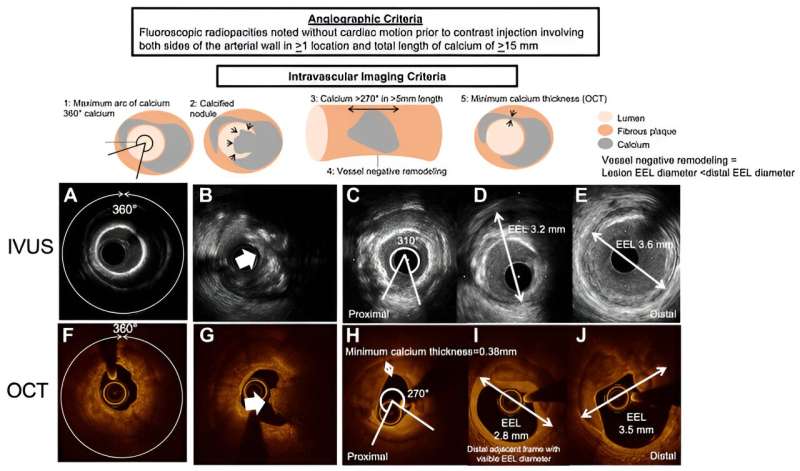This article has been reviewed according to Science X's editorial process and policies. Editors have highlighted the following attributes while ensuring the content's credibility:
fact-checked
trusted source
proofread
Expert consensus statement published on management of calcified coronary lesions requiring intervention

Coronary artery calcification is increasing in prevalence, leading to greater risks both during procedures such as percutaneous coronary intervention (PCI) and adverse events in the short and long term. Along with these challenges, treatment options are expanding, increasingly including calcium modification prior to stent implantation.
A newly published SCAI Expert Consensus Statement on the Management of Calcified Coronary Lesions, appearing in Journal of the Society for Cardiovascular Angiography & Interventions, outlines methods for interventional cardiologists to identify various types of calcified coronary lesions and presents an algorithm to help them guide the use of these various calcium modification strategies.
"This expert consensus statement incorporates detailed tips for the use of each treatment modality and the latest in emerging trials and therapies to help interventional cardiologists rise to these challenges," said SCAI President George D. Dangas, MD, Ph.D., MSCAI.
In addition to outlining methods for identifying various types of calcified lesions and reviewing the different calcium modifying tools, "the document provides images using two different types of intravascular imaging technology and a consensus of practical tips when using the different treatment strategies, including in the use of different types of calcified lesion subsets," said Binita Shah, MD, MS, FSCAI, Chair of the document's writing committee, associate professor of medicine at NYU School of Medicine and associate director of interventional cardiology for VA NY Harbor Healthcare System.
"We bring the data and our experience all together with an algorithm designed to identify and address the various calcified CAD phenotypes. Our group is proud of this document and the uniqueness of it," Shah added.
Among the consensus document's many takeaways, highlights include:
- Calcified coronary lesions are becoming commonplace in the cardiac catheterization lab, and their treatment is associated with increased short- and long-term risks compared to noncalcified lesions.
- The use of intravascular imaging and the proper use of calcium modification devices can help decrease these risks.
- The authors propose an algorithm for how to identify and treat these lesions with the various currently available calcium modification devices, along with tips and tricks for using these devices.
"This consensus statement is meant to increase awareness about the prevalence of calcified coronary lesions, the ramifications of testing these lesions when indicated, the various treatment options available including tips for using them, and offer an algorithm for choosing between these treatment options," said Robert F. Riley, MD, MS, FSCAI, director of the complex coronary therapeutics program at Overlake Medical Center & Clinics.
For the interventional cardiologist community, "our hope is that this document aids in improving outcomes for some of our most challenging patients," said Mitul Patel, MD, FSCAI, interventional cardiologist, VA San Diego Health System.
More information: Robert F. Riley et al, SCAI Expert Consensus Statement on the Management of Calcified Coronary Lesions, Journal of the Society for Cardiovascular Angiography & Interventions (2024). DOI: 10.1016/j.jscai.2023.101259




















